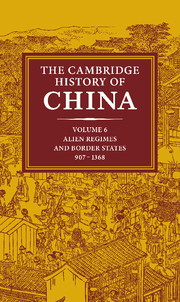Book contents
- Frontmatter
- Introduction
- 1 The Liao
- 2 The Hsi Hsia
- 3 The Chin dynasty
- 4 The rise of the Mongolian empire and Mongolian rule in north China
- 5 The reign of Khubilai khan
- 6 Mid-Yüan politics
- 7 Shun-ti and the end of Yüan rule in China
- 8 The Yüan government and society
- 9 Chinese society under Mongol rule, 1215–1368
- Bibliographical essays
- Bibliography
- Glossary-Index
- MAP 7. The Liao empire, ca. 1045
- MAP 12. The Hsi Hsia state, IIII
- Map 17. The Chin empire
- MAP 32. The Yüan empire">
- References
8 - The Yüan government and society
Published online by Cambridge University Press: 28 March 2008
- Frontmatter
- Introduction
- 1 The Liao
- 2 The Hsi Hsia
- 3 The Chin dynasty
- 4 The rise of the Mongolian empire and Mongolian rule in north China
- 5 The reign of Khubilai khan
- 6 Mid-Yüan politics
- 7 Shun-ti and the end of Yüan rule in China
- 8 The Yüan government and society
- 9 Chinese society under Mongol rule, 1215–1368
- Bibliographical essays
- Bibliography
- Glossary-Index
- MAP 7. The Liao empire, ca. 1045
- MAP 12. The Hsi Hsia state, IIII
- Map 17. The Chin empire
- MAP 32. The Yüan empire">
- References
Summary
GOVERNMENT
The structure of Yüan government took shape during the reign of Khubilai (Emperor Shih-tsu, r. 1260–94). Although institutional functions and forms shifted throughout the Yüan period, the essential components of the government bureaucracy formulated under Khubilai remained intact until the end of the dynasty in 1368.
Khubilai himself supplied many of the innovations in government. He heeded the advice of Chinese, Khitans, Jurchens, Turkic Uighurs, Tibetan Buddhists, and Mongols in order to create a bureaucratic system that reflected all these various cultures. The official terminology of Yüan bureaucracy might lead to the conclusion that Khubilai merely adopted an almost purely Chinese structure of government, but in fact, the Yüan bureaucracy consisted of a mixture of different political and cultural elements. Even the “purely Chinese” elements of Yüan bureaucracy can be traced to Khitan Liao, Jurchen Chin, and Chinese T'ang–Sung governments.
The strongest Chinese influence at Khubilai's early court came from Liu Ping-chung (1216–74), a Ch'an Buddhist and confidant of the Mongolian emperor. Under the direction of Liu Ping-chung and a small group of Chinese advisers, including Wang O (1190–1273), Yao Shu (1202–79), and Hsü Heng (1209–81), a central government administration was established within the first decade of Khubilai's reign. The traditional Chinese tripartite division of authority among civil, military, and censorial offices was kept intact (at least on paper) by the establishment of the Central Secretariat (Chung-shu sheng) to manage civil affairs, the Privy Council (Shu-mi yüan) to manage military affairs, and the Censorate (Yü-shih t'ai) to conduct internal surveillance and inspection.
Keywords
- Type
- Chapter
- Information
- The Cambridge History of China , pp. 587 - 615Publisher: Cambridge University PressPrint publication year: 1994
References
- 7
- Cited by



